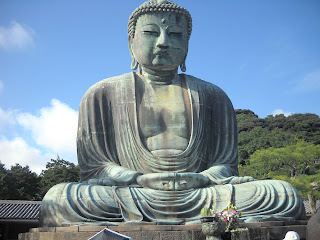(source)
This print is by the artist Saito Kiyoshi with the title Saga Kyoto (D).
Saitou Kiyoshi was a Sousaku-hanga artist, or a woodblock artist whom completed all of the steps himself. The Sousaku-hanga art movement attempted to place self reliance on the artist, and to distance the artist from other parties involved. This was designed to let the artist express themselves more freely, and make art for the sake of art.
Saitou is known for mixing traditional elements with modern aspects, mostly featuring architecture and plants. In his early works, Saitou focused on realism, with a higher degree of depth. As he progressed, Saitou flattened his works and added a modern touch.
This particular print was finished in 1968, and was titled 'Saga Kyoto (D)'. The 'D' denotes the 4th work to bear the title 'Saga Kyoto'. Overall, the scene appears as if the viewer is in some sort of structure and is looking outward.
One thing that I have noticed by looking through a few of Saitou's work's is his use of textures. As his works are flat, texture helps to add a different feeling to a surface without making it look 3 dimensional. Here, he does not use multiple textures as he does in some images, but rather uses one overarching grainy texture. In this image, the grainy texture could be used to denote that the scene is occurring at night, or a sense of fogginess. Either way, the grain darkens the image and connotes a sense of mystery or uncertainty. The grain also gives different qualities to the colors used; the green 'plant' is brighter than some of the brown 'wood' for instance, because the green was painted over the grain, while the brown was painted under it.
Throughout the image there is also a seemingly purposeful sense of inconsistency. The view through the gate/door structure is different from the inside, blocks of color extend over areas where one would not expect them to (with our perceived thought of what the image is), plants and poles are very similar in form, etc. This all ties in with the flat quality of the image. Without any clear perspective, multiple views are available to the viewer, creating different possibilities within the image. This also makes it so that what the shapes and colors in the image represent are harder to distinguish individually; one must look at the whole image, to grasp what one part of it may be, and even then, it is unclear.
Overall, the image exudes a sense that was it displays cannot be totally grasped. This perhaps plays on our use of signs to discern the meaning in an image.

